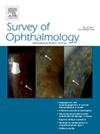Adjustable suture versus nonadjustable suture surgery for childhood strabismus: A meta-analysis
IF 5.9
2区 医学
Q1 OPHTHALMOLOGY
引用次数: 0
Abstract
We compare the success rate and reoperation rate between adjustable suture (AS) and non-adjustable suture (NAS) in the treatment of strabismus in pediatric patients. We conducted a comprehensive search of scientific databases, including Pubmed, Medline, Embase, Web of Science, and the Cochrane Register of Controlled Trials prior to November 30, 2023., aiming to identify eligible studies for meta-analysis that compared AS versus NAS in patients with strabismus. The differences observed between AS and NAS were quantified as risk differences (RDs) and risk ratios (RRs) along with 95 % confidence intervals (CIs). The data on success rates and reoperation rates were pooled using fixed or random effects model according to the degree of heterogeneity between studies. Subgroup analyses were further performed in patients with exotropia and esotropia. Five studies with 8744 patients were included in this meta-analysis. The success rates observed in the AS group were markedly superior to those in the NAS group, with a RD of 0.17 (95 % CI, 0.11–0.24; P < 0.001) and a RR of 1.26 (95 % CI, 1.15–1.37; P < 0.001); however, there was no significant difference in the reoperation rates between the AS and NAS groups, with a RD of −0.04 (95 % CI, −0.10–0.02; P = 0.19) and a RR of 0.66 (95 % CI, 0.40–1.10; P = 0.11). In the subgroups of exotropia and esotropia, the effect of AS on prognosis was similar. We found that the AS technique can significantly improve the success rate of surgery in the early postoperative period. More evidence-based evidence is needed in the future to confirm whether there is an advantage in the long-term success rate of AS technique.
儿童斜视可调节缝合与不可调节缝合手术:一项荟萃分析。
我们比较了可调节缝合(AS)和不可调节缝合(NAS)治疗小儿斜视的成功率和再手术率。在2023年11月30日之前,对Pubmed、Medline、Embase、Web of Science和Cochrane Register of Controlled Trials等科学数据库进行了全面检索,旨在确定符合条件的研究进行meta分析,比较AS与NAS在斜视患者中的作用。AS和NAS之间观察到的差异被量化为风险差异(RDs)和风险比(RRs)以及95%置信区间(ci)。根据研究间的异质性程度,采用固定效应或随机效应模型对成功率和再手术率数据进行汇总。对外斜视和内斜视患者进一步进行亚组分析。这项荟萃分析纳入了5项研究,共8744例患者。AS组的成功率明显优于NAS组,RD为0.17 (95% CI, 0.11~0.24;P
本文章由计算机程序翻译,如有差异,请以英文原文为准。
求助全文
约1分钟内获得全文
求助全文
来源期刊

Survey of ophthalmology
医学-眼科学
CiteScore
10.30
自引率
2.00%
发文量
138
审稿时长
14.8 weeks
期刊介绍:
Survey of Ophthalmology is a clinically oriented review journal designed to keep ophthalmologists up to date. Comprehensive major review articles, written by experts and stringently refereed, integrate the literature on subjects selected for their clinical importance. Survey also includes feature articles, section reviews, book reviews, and abstracts.
 求助内容:
求助内容: 应助结果提醒方式:
应助结果提醒方式:


